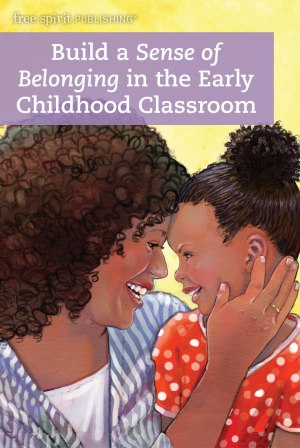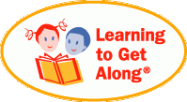Build a Sense of Belonging in the Early Childhood Classroom
By Cheri J. Meiners, M.Ed., author of the Learning About Me & You, Learning to Get Along®, and Being the Best Me series.
 Mr. Rogers was a strong advocate for children. In his much acclaimed and long running television show Mr. Rogers’ Neighborhood, he treated children gently and warmly and made them feel that they were a part of his intimate circle of friends. Mr. Rogers understood that a sense of belonging is a basic human need and that it is vital to children’s social and emotional development. He assured children regularly, “I like you just the way you are.” Mr. Rogers addressed the following three important aspects of belonging that helped children feel like they belonged to a community of caring people and that they were an integral part of it:
Mr. Rogers was a strong advocate for children. In his much acclaimed and long running television show Mr. Rogers’ Neighborhood, he treated children gently and warmly and made them feel that they were a part of his intimate circle of friends. Mr. Rogers understood that a sense of belonging is a basic human need and that it is vital to children’s social and emotional development. He assured children regularly, “I like you just the way you are.” Mr. Rogers addressed the following three important aspects of belonging that helped children feel like they belonged to a community of caring people and that they were an integral part of it:- a place to go
- something to do
- someone to help
With these three aspects of belonging in mind, let’s take a look at what Mr. Rogers did and how we can help children at home or in a preschool setting feel that they are needed and valued and that they have a special place in our lives.
A Place to Go
Mr. Rogers spoke to young viewers directly as individuals, built up their self-esteems, and helped them feel that his neighborhood (and theirs) was a safe place to be.
Mr. Rogers spoke to young viewers directly as individuals, built up their self-esteems, and helped them feel that his neighborhood (and theirs) was a safe place to be.
We can get to know each child in our care and find an admirable quality in them to encourage. Address children by name and compliment them consistently for their achievements and efforts. Where possible, give young children calming touch, such as a pat on the head or shoulder, a handshake, a high five, or a hug. At school, have circle times where children can talk about themselves and their backgrounds to establish a caring network. In your home, you can hang pictures of extended family and tell stories about those people. Talk regularly with these family members on the phone.
Something to Do
Mr. Rogers introduced children to community helpers, showing children that all types of people and vocations play a part in enriching our communities. He enlarged their world by touring factories and demonstrating experiments, crafts, and music. From this, children saw that they, too, could develop important skills and talents and have something important to contribute.
Mr. Rogers introduced children to community helpers, showing children that all types of people and vocations play a part in enriching our communities. He enlarged their world by touring factories and demonstrating experiments, crafts, and music. From this, children saw that they, too, could develop important skills and talents and have something important to contribute.
We can assign chores to children or let them be “helpers” for simple tasks. In a preschool setting, give children time to share about their lives and interests and to feel that they are making a contribution. Invite guest speakers, take field trips, and plan classroom experiences that teach new skills. Expose children to a wide range of community helpers and these people’s roles. Let children know that the things they are learning and doing are also useful and important to the family or class.
Someone to Help
Mr. Rogers showed respectful ways to solve problems. Children saw demonstrations of kindness and of how to get along with and help others.
Mr. Rogers showed respectful ways to solve problems. Children saw demonstrations of kindness and of how to get along with and help others.
Praise children for their positive efforts, kind words, and inclusive actions that you notice. Be attentive in catching them doing nice things. We can prompt, teach, demonstrate, and affirm kind and gentle conversations, interactions, and ways to solve problems. One of the greatest ways to do this is by taking a positive approach using the “three-to-one” rule of thumb. If you feel that you need to make a correction, find at least three positive things that you can say to balance the one correction. Be specific in identifying and acknowledging those admirable behaviors. Make a point to include children who need extra attention. By loving children, including them, and sincerely caring about their well-being, you are also modeling to children how to treat others with kindness.
Try the following belonging activities to demonstrate how we all need one another and that each child fits in, is valued, and has an important role to play.
Activity 1: Making Our Mark
Materials: drawing paper or poster paper, ink pad, crayons or markers
Materials: drawing paper or poster paper, ink pad, crayons or markers
Directions: Help each child draw a simple tree with branches (or do this step yourself ahead of time). Let children press a finger to an ink pad and use their inked fingers to make marks in different spots on their trees for each person in their families they want to include. Write in the names of each person. Discuss questions like, “What does your family do to show you they love you and that you belong?” “How do you feel when you do something together with your family?”
Variation: For a classroom setting, create a poster representing your classroom circle. Have each child add a fingerprint in a circle. Help children write their names under their prints. Talk about how fingerprints are unique, just as children are, and that each child belongs in the circle of your class. Discuss questions like “What are things you like to do in class?” “What is a way you like to help our class?”
Activity 2: “Who Does This Belong To?” Circle Game
Directions: Have children sit in a circle. Ask each child to take off a shoe and put it in the center of the circle. Choose a child to go to the center and hold up a shoe. Help the child ask, “Who does this belong to?” The child who owns the shoe will say, “It’s mine,” or, “That shoe belongs to me.” Then ask the group, “Who does the shoe belong to?” Children can answer together, “The shoe belongs to (name the child).”
Directions: Have children sit in a circle. Ask each child to take off a shoe and put it in the center of the circle. Choose a child to go to the center and hold up a shoe. Help the child ask, “Who does this belong to?” The child who owns the shoe will say, “It’s mine,” or, “That shoe belongs to me.” Then ask the group, “Who does the shoe belong to?” Children can answer together, “The shoe belongs to (name the child).”
The child in the center returns the shoe to the child it belongs to. That child can put on the shoe and continue the game by going to the center.
Discussion: Talk about belonging using the shoes as an example. Explain that things that belong to us are helpful and important to us. Tell children why they are important to you. As a family or class, you belong together because you like each other, you want to be together, and you help one another. Discuss how doing things together and helping one another can help us feel that we belong.
Activity 3: Which Things Belong Together?
Preparation: Gather items such as those in the following table. You may use the actual item, a toy version, or pictures. Note: Gather items that belong together based on the purpose of the items, not on how they look.
Preparation: Gather items such as those in the following table. You may use the actual item, a toy version, or pictures. Note: Gather items that belong together based on the purpose of the items, not on how they look.

Directions: Put two or three items from the same category on the table along with one item that doesn’t fit. Ask, “Which things belong together?” Or prompt students by asking, “Which of these help us to (name category)?”
Discussion: Ask questions like, “Why do these things belong together?” “What do these items help us do?” Explain that although we are all different in some ways, we can do things together, work together, and help each other.
 Cheri J. Meiners, M.Ed., has her master’s degree in elementary education and gifted education. A former first-grade teacher, she has taught education classes at Utah State University and has supervised student teachers. Cheri and her husband David have six children and enjoy the company of their lively grandchildren. They live in Laurel, Maryland.
Cheri J. Meiners, M.Ed., has her master’s degree in elementary education and gifted education. A former first-grade teacher, she has taught education classes at Utah State University and has supervised student teachers. Cheri and her husband David have six children and enjoy the company of their lively grandchildren. They live in Laurel, Maryland.
Free Spirit book series by Cheri Meiners:
- Get link
- X
- Other Apps




